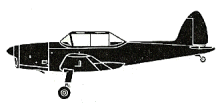
ASN Wikibase Occurrence # 139741
This information is added by users of ASN. Neither ASN nor the Flight Safety Foundation are responsible for the completeness or correctness of this information.
If you feel this information is incomplete or incorrect, you can submit corrected information.
| Date: | Tuesday 25 February 1997 |
| Time: | 10:00 |
| Type: |  de Havilland Canada DHC-1 Chipmunk 22 |
| Owner/operator: | Royal Aero Club of Western Australia |
| Registration: | VH-RWI |
| MSN: | C1/0164 |
| Fatalities: | Fatalities: 0 / Occupants: 2 |
| Aircraft damage: | Substantial |
| Location: | 25 km SE Jandakot, Perth, WA -
 Australia Australia
|
| Phase: | Landing |
| Nature: | Training |
| Departure airport: | Jandakot (JAD/YPJT) |
| Jandakot (JAD/YPJT) | |
| Confidence Rating: |
The aircraft was being used for endorsement training of a foreign tourist. It had been operating in the training area east of Jandakot for approximately one hour and was engaged in general handling manoeuvres and aerobatics.
Having completed these manoeuvres, the instructor decided to conduct practice forced landing training. During the first approach, from an altitude of 2,500 ft, the instructor reported that the throttle had been opened twice and the engine had responded normally.
The instructor reported that at 200 to 300 ft, with 30 degrees of flap set, he instructed the student to commence a go-around. He reported that the student raised the nose attitude and opened the throttle but the engine did not respond. The student was flying the approach at 65 knots. The stall speed in the finals configuration was approximately 42 knots. The recommended
climb speed was 60 knots.
The instructor reported that he checked that the throttle was fully open. He also noticed the airspeed reducing. He took over and attempted to lower the nose attitude to prevent the aircraft stalling but the aircraft did not seem to accelerate. He called to the student to check that the fuel
was on.
The instructor reported that he had turned right, then left to avoid a tree and line up on a paddock. He did not assess the rate of descent as being excessive until he tried to flare the aircraft for landing. He did not recall the engine power recovering before impact. Wreckage evidence indicated that the engine was delivering high power at impact. The wreckage and ground marks also indicated that the aircraft had struck the ground in a flat attitude at relatively low
ground-speed. There was sufficient fuel and the fuel selector had been selected to the left tank
Sources:
http://www.atsb.gov.au/publications/investigation_reports/1997/aair/aair199700590.aspx
https://www.airplane-pictures.net/registration.php?p=VH-RWI
https://www.pprune.org/aviation-history-nostalgia/385363-chipmunk-beautiful-8.html
Revision history:
| Date/time | Contributor | Updates |
|---|---|---|
| 08-Nov-2011 15:00 | Dr. John Smith | Added |
| 07-Jun-2022 20:24 | Ron Averes | Updated [Location, Narrative] |
| 07-Jun-2022 21:45 | Ron Averes | Updated [Location] |
Corrections or additions? ... Edit this accident description
The Aviation Safety Network is an exclusive service provided by:


 ©2024 Flight Safety Foundation
©2024 Flight Safety Foundation